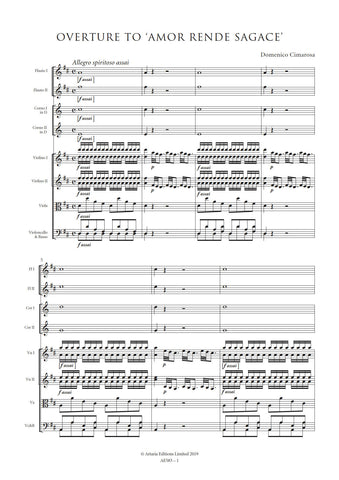Details
|
Il convito (The Banquet) was Domenico Cimarosa's 28th opera, written on commission from Teatro San Samuele in Venice for the Carnival season of 1782, the commission resulting from the success of his dramma giocoso, Giannina e Bernadone which he had written a year earlier for the same theatre.With the libretto by Filippo Livigni, the story tells of Massimo, a clumsy old gentleman who is holding an elegant banquet to which Alfonsina, a capricious widow, has been invited. The guest list also includes Count Polidoro who is engaged to Eleonora; the Cavalier del Lampo arrives uninvited, and all three men discover they are amorously attracted to Alfonsina. After a nocturnal scene in which Polidoro and del Lampo parade as statues, the 'oracle' of this scene of disguise and fantasy announces who shall marry whom, and the finale involves the three happy couples.
Following the success of Il convito in Venice (the remarks in Grove's Dictionary of Opera being quite to the contrary) - the composer was carried by torchlight back to his hotel after the performance - the opera was produced the following season in Prague, Trieste, Dresden (as Das Gastmahl), Turin (as Il convito di pietra) and Nice.Within the next two decades it was mounted in Madrid, Frankfurt (as Der Schmaus) ,Warsaw,Madrid, Mannheim, Salzburg,Marseilles, Lisbon and, in 1803, in Paris. The only performance since that date was a revival by Studio Lirico of Cortona, Italy, at Teatro Signorelli in 1994 in a contemporary performing edition by Talmage Fauntleroy and the present writer.
There are two different overtures to Il convito. The one printed here, in three movements, may be found in the composer's holograph score in the Conservatorio di musica 'S Pietro a Majella' library in Naples, Rari 1-2-9, dated 1791 (in spite of the fact that the opera's prima was in 1782). The second overture, in one movement, preserved in manuscript in The British Library under the shelfmark Add.MS 15994, was apparently prepared for a performance of the opera before the court of Naples. Scored for pairs of oboes and horns, timpani and strings (with divided violas and separate violoncello and contra basso lines), it is identical to the fifth overture of the five Cimarosa wrote for his L'impresario in angustie (GB Lbl Add.MS 15995) which the library dates "about 1786".
The present overture is one of several by Cimarosa cast in three movements (the three-movement overtures are nearly all found in early works): Allegro brioso - Andante con moto espressivo (cast unexpectedly in B flat) - Allegro presto. It is interesting to note that the first and third movements of this overture closely resemble the first and third movements of a work edited by Ugo Rapalo in 1966 and published by Zanibon as Cimarosa's Sinfonia in Re Maggiore per archi, flauto, oboi e corni. In his preface to the edition, Signor Rapalo explains that the autograph of the symphony has never been found and that he obtained his manuscript parts (which carry no indications of provenance) from the library of the conservatory in Naples. The present librarian knows of no such set of parts in that Neapolitan library.
This edition is based on the composer's holograph score which is preserved in the library of the Conservatorio di music 'S Pietro a Majella', Naples, under the shelfmark Rari 1-2-9,10. As is the case with all Cimarosa's autograph material the overture to Il convito shows signs of having been composed at breakneck speed. Every conceivable notational shortcut is taken and his placement of articulation and dynamic markings is erratic. It has been necessary, therefore, to frequently interpret the composer's intentions and even at times to impose an editorial solution where his own thoughts are not clear. Cimarosa's horn notation is often problematic and in this instance the editor has decided to adopt the conventional 18th-century practice of writing the horn parts in C, in the treble clef. In making sense of Cimarosa's score the style and notation of articulation and dynamic markings have been largely standardised throughout, and, where missing, markings have been reconstructed from parallel passages. These are indicated by the use of dotted slurs or brackets where appropriate. Obvious wrong notes have been corrected without comment; editorial emendations with no authority from the source are placed within brackets.
Nick Ross
|














